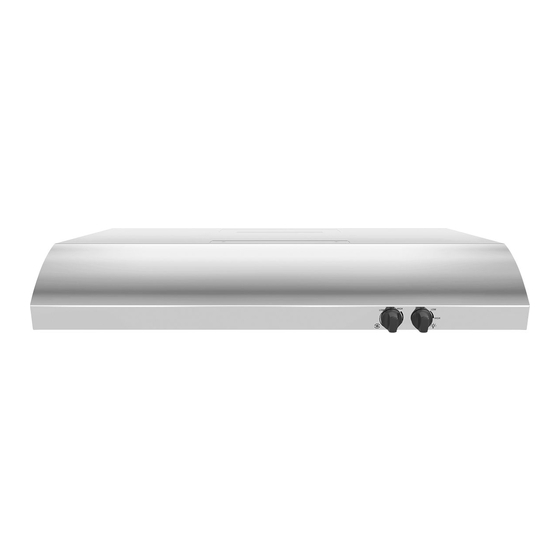- ページ 5
換気フード Whirlpool UXT4236AYWのPDF 取付説明書および取扱説明書をオンラインで閲覧またはダウンロードできます。Whirlpool UXT4236AYW 32 ページ。 30" (76.2 cm) and 36" (91.4 cm) range hood

Installation Clearances
B
A
E
A. 18" (45.7 cm) min. clearance - upper cabinet to countertop
B. 18" (45.7 cm) to 24" (61.0 cm) suggested max. - bottom of range
hood to cooking surface
C. 30" (76.2 cm) min. cabinet opening width for 30" (76.2 cm)
models and 36" (91.4 cm) min. cabinet width for 36" (91.4 cm)
models
D. 13" (33.0 cm) cabinet depth
E. 36" (91.4 cm) base cabinet height
Venting Requirements
Vent system must terminate to the outdoors, except for non-
vented (recirculating) installations.
Do not terminate the vent system in an attic or other enclosed
area.
Do not use a 4" (10.2 cm) laundry-type wall cap.
Use a 7" (17.8 cm) round metal vent or a 3 " x 10"
(8.3 x 25.4 cm) rectangular metal vent, depending on your
installation requirements. Rigid metal vent is recommended.
Plastic or metal foil vent is not recommended.
The length of vent system and number of elbows should be
kept to a minimum to provide efficient performance.
For the most efficient and quiet operation:
Use no more than three 90° elbows.
Make sure there is a minimum of 24" (61 cm) of straight vent
between the elbows if more than 1 elbow is used.
Do not install 2 elbows together.
Use clamps or duct tape to seal all joints in the vent system.
C
D
The vent system must have a damper. If roof or wall cap has a
damper, remove the damper flap from the vent damper
supplied with the range hood. (See "Damper Flap Removal
for 3¼" x 10" [8.3 x 25.4 cm] Vent Connector" in the "Install
the Range Hood" section.)
NOTE: If a damper is used, the range hood may not meet
California Title 24 compliance.
Use caulking to seal exterior wall or roof opening around the
cap.
Cold Weather Installations
An additional back draft damper should be installed to minimize
backward cold air flow and a thermal break should be installed to
minimize conduction of outside temperatures as part of the vent
system. The damper should be on the cold air side of the thermal
break.
The break should be as close as possible to where the vent
system enters the heated portion of the house.
Makeup Air
Local building codes may require the use of makeup air systems
when using ventilation systems greater than specified CFM of air
movement. The specified CFM varies from locale to locale.
Consult your HVAC professional for specific requirements in your
area.
Venting Methods
Vent system can terminate either through the roof or wall. Use
3 " x 10" (8.3 x 25.4 cm) rectangular with a maximum vent
length of 35 ft (10.7 m) or 7" (17.8 cm) or larger round vent with a
maximum length of 50 ft (15.2 m) for vent system.
NOTE: Flexible vent is not recommended. Flexible vent creates
both back pressure and air turbulence that greatly reduce
performance.
Roof Venting
B
A
C
A. 7" (17.8 cm) round vent
through roof
(purchased separately)
3 " x 10" (8.3 x 25.4 cm)
rectangular vent through the
roof (purchased separately)
B. Roof cap with damper
(purchased separately)
C. 18" (45.7 cm) min. to
24" (61.0 cm) max. above the
cooking surface
Wall Venting
A
B
C
A. 7" (17.8 cm) round vent out the
top and through the wall
(purchased separately)
3 " x 10" (8.3 x 25.4 cm)
rectangular vent through the
wall or out the top (purchased
separately)
B. Wall cap with damper
(purchased separately)
C. 18" (45.7 cm) min. to
24" (61.0 cm) max. above the
cooking surface
5
